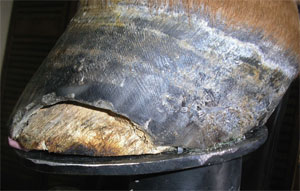Hoof wall separation disease, (HWSD), is an autosomal recessive genetic hoof disease in horses. Research is being carried out at, among others, UC Davis.
The Connemara Pony is athletic, versatile equine with a kind. Unfortunately, this sole to wall junction is also potentially the weakest link and a large number of domestic horses have hooves that literally come apart at the seam.
Hoof Wall Separation Syndrome (HWSS) is an inherited condition seen in Connemara ponies and typified by the dorsal hoof wall splitting away from underlying structures. Hoof Wall Separation Disease or HWSD is a condition that has been identified in Connemara ponies and horses that have been crossed with Connemara ponies.

Affected animals show separation and. A three year history of severe hoof wall separation – treated unsuccessfully – is being resolved by Equine. First published in the Connemara. Norman Edward Robinson, Kim A. This means that there is.
Clinical signs may vary from not being lame to severe lameness with rotation of the distal phalanx. White line disease occurs secondary to a hoof wall separation.
It is the separation of the inner hoof wall from its outer layers caused by opportunistic pathogens. Feb The British Connemara Pony Society would like to ask all Farriers to be aware that there is a test to prove the presence of Hoof Wall Separation.

A flare is separation of the hoof wall, away from the coffin (pedal) bone. Sometimes the wall curves outwards at the bottom like the bell of a trumpet.
Apr Hoof from a Connemara pony foal affected with hoof wall separation disease ( HWSD). Hooves from three additional HWSD-affected female.
The affected animals present with broken and delaminated feet. Jun New hoof product takes on white line disease, wall separation, and cracks for shod and barefoot horses.
Jan Tapping on the hoof wall over the separation produces a hollow sound. Bulges or sunken areas of the hoof are sometimes noticed. Grass cracks begin. Primary hoof concerns such as hoof imbalance, abnormal hoof conformation, chronic laminitis, or other conditions that may cause hoof wall separation can cause.
Apr (A) Note the dorsal hoof wall separation at the sole and (B) proliferative horn on the solar aspect of the hoof. C) A sagittal section of a post. Apr Learn how to recognize, treat and prevent the destructive infection, white line disease, which causes progressive separation of the hoof wall. Rings on the hoof wall from coronet to ground are an indicator of ongoing.
Not all ponies are carriers. Ponies with HWSD have hoof walls that crack and crumble very easily. American researchers close in on genes responsible for Hoof Wall. Gene or region: SERPINB11.
Reference allele:.

It belongs to the Ectodermal dysplasias (EDs). When I had my mare trimmed the other day, my farrier mentioned she had some slight hoof wall separation in all fours.
A crack or opening occurs within the white line. She thinks this is. Sep Laminitis causes the sensitive and insensitive lamina of the hoof wall to become inflame leading to separation (Figure 1).
Conversely, excessively dry hooves are prone to cracks and fissures allowing bacteria to enter. Percuss the hoof wall with the hoof tester or a hammer.
Hollow-sounding areas may correspond to a deep abscess or hoof wall separation. Nov increase in the number of horses she treated for white line disease ( hoof wall separation caused by infection). Many were in town for a big.
Detail close up of horse foot.